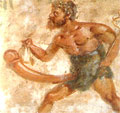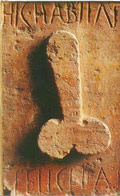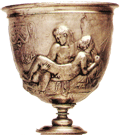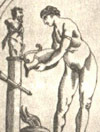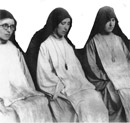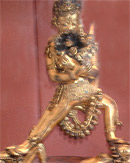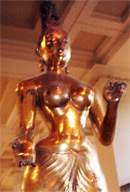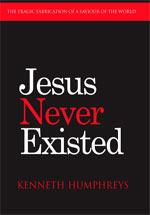"Beware of the Penis"
"Priapus, over-endowed and over-sexed by definition ... warded off petty thieves, upon whom, if caught, he would inflict the homosexual punishment."
– Antonio Varone, Eroticism in Pompeii, p14/5.
Sign of the Happy Penis
"Here dwells happiness" – House of Pansa, Pompeii
Denarius of Domitian, 85 AD.
A half-naked Germania."Even the reverses of the Greek and Roman coins were frequently of an idolatrous nature. Here indeed the scruples of the Christian were suspended by a stronger passion."
– Edward Gibbon, Decline and Fall, 15.
Unholy Grail?
On a fine silver cup, a man has sex with a youth.
From the House of Menander, 1st century Pompeii ('Warren cup', British Museum).
Randy god becomes heroic Christian martyr
In a curious recycling of ancient piety, Priapus metamorphosed into a noble Christian saint!
Supposedly, the first bishop of Lyons was "Pothinus", who (in his 90th year, no less) was cruelly martyred by that dastardly Marcus Aurelius, actually the most sublime of Roman emperors.
His death, along with a claimed fifty others, became a cause célèbre of Christian heroics, the "martyrs of Lyons" – though we are indebted to the 4th century propagandist Eusebius as our witness to this doubtful episode.
Pothin's name in time became Foutin, giving rise to the verb foutre (“to fuck”). Shrines to Saint Foutin sprang up all over the region.
Scrapings from the saint's wooden phallus were made into a portion, providing a fertility service for women hoping to get pregnant.
(Confession de Sancy, Pierre de L'Estoile)
Christian sex attitudes?
"Carnal woman"
"Nothing is so powerful in drawing the spirit of man downwards as the caress of a woman and that physical intercourse which is part of marriage."
– Augustine, Soliloquies.
In his major work Civitate Dei (City of God) St Augustine, the first theologian in the west, counterpoised an eternal Christian "spirituality" to a doomed material world.
Ever a Manichaean?
Nip and tuck
Christianity did not require circumcision (though it continued among the Coptic Christians of Egypt and Ethiopia) but it did countenance castration (de rigueur in the bureaucracy of Byzantium).
Glorification of chastity
Nuns get none. But they love Jesus.
"The only unnatural sexual behaviour is none at all." – Freud
As Christianity edged closer to worldly power, chastity replaced charity as the central calling of the faith.
Love demanded
" Jesus said unto him, Thou shalt love the Lord thy God with all thy heart, and with all thy soul, and with all thy mind.
This is the first and greatest commandment."– Matthew, 22.38.
Love given
" I do believe in the scripture and am in love with God and that he sent his son to die for me ... Having a friend that will never leave me or forsake me is a comfort as I watch this world unfold at the seams."
– email to JNE, 2nd March 2007.
As the 2nd and 3rd centuries passed and it became only too obvious that there would be no imminent return of the godman, the church and its theorists had to adjust to the reality – and opportunity – of an institutional church and a human race that would perpetuate itself whatever madness the theologians urged. Following the example of the Jewish priests, who collected all manner of "offerings" for unclean sexual practices, the henchmen of Christ would regulate, exploit and license human sexuality on a truly monumental scale.
Sexual mores of the Romans Natural, Normal and Exotic
In all things, the Roman public had an appetite for the spectacular and the exotic. The theatre, aside from the entertainments of comedy, tragedy and farce, featured a wide variety of eroticism, including naked acrobats and burlesque shows in which the sex act was either mimed or performed. The 1st century poet Martial records bestiality performed as public entertainment (Spectacula 5). In taverns, waitresses might provide sexual services for customers. Suetonius noted that nude girls served at banquets (Life of Tiberius 42.2). A late Roman (and Christian!) emperor, Justinian, even married a performer from the circus famous for her erotic buffoonery and made her empress. Yet "fertility" had an official, and pragmatic purpose: promotion of the family. The empire was always in need of manpower. For all its civilisation, life expectancy in the Roman world was not great. Female death in childbearing was a common fate. An expansive empire needed its colonists. Society expected its citizens to expend their sexual energies in begetting and rearing children. Even the Vestal Virgins were free to marry later in life, their chastity in no sense an exemplar for society as a whole. Marriage was encouraged. Widows and widowers remarried. They did not yet retreat into "piety" or perpetual mourning nor lavish the family legacy on the Church. Augustan laws penalized bachelors and rewarded families. Young girls early in life were utilised as baby factories; the median age for marriage may have been as low as 14.
Pleasure – a distraction from God
But time passed, the Lord did not come, and the first generation of the brethren "fell asleep". To replace the dead, marriage, solely for the purpose of procreation, became tolerable, at least within the faith. But the marriage bonds came with the caveat of indissolubility. They would last for the eternal age yet to come and a remarriage was nothing less than adultery. Like every subsequent apocalyptic cult that has boldly proclaimed the End Time and embarrassingly survived into a new era, Catholicism adroitly adjusted its doctrine for the "long haul".
Catholicism – a compromise with reality How could the early evangelists of Christianity compete with the taverns, the circuses, the theatres, the baths and the bordellos that graced every Roman city? Only with difficulty, only by exploiting the misfortunes that befell the Roman world and only by appealling to neglected marginal elements ("matrons and orphans") of the population (even slaves could attend the games). Catholicism was an opportunistic compromise in the face of need and opportunity for a universal faith. Within two or three generations it outgrew its early austere fanaticism (refusal to serve in the legions, will to martyrdom). Fanatics like Tertullian left to join marginal sects of purists, leaving more urbane Catholic bishops to frequent the corridors of the imperial palaces. Orthodoxy borrowed without embarrassment or apology from its enemies and in particular drew from the books of gnostic heresy. "Pleasures of the flesh" remained an enemy, just as surely as the fertility gods and goddesses of the pagans who delighted in procreation. But now a taste of power favoured accommodation and rapprochement with a disbelieving world. In an age when Judgement Day and the Kingdom of Heaven had been anticipated at any moment, celibacy and denial of the body had a passable rationale. The world was about to end. But as the Apocalypse retreated further and further beyond the horizon, few could succumb to Christianity's austere, joyless dictates without penalty. Those who did, reclusive hermits, anchorites, stylites and the rest of the menagerie, were lionized by a more worldly church. Admired and applauded for their "heroic piety" and useful as propaganda for the faith, they were contained within a more pragmatic and universal Church. A triumphant Catholicism would forgive "pleasures of the flesh". After all, huge profits were to be derived from venial sin.
A celibate priesthood? From the very foundation of the Church, "sins of the clergy" permeated the organisation from top to bottom. Before the patronage of the Roman state filled the coffers of the Church, rich Roman matrons paid the bills, fed the priests and made their great houses over as meeting places for the brethren. The priest, as a respected and powerful figure, was often left alone with a cheerless widow or a vulnerable novice. He became privy to the most intimate confidences and indiscretions. The temptations, both venal and carnal, were many. His position was most privileged. Who but a churchman could visit a woman in her home while her husband was away? Who could question the calling of lay women into the presbyteries of the clergy – or doubt the wisdom of entrusting minors into their care? Pagan critics often questioned the purported purity of the saints. Even the epistle of James had a cryptic warning, cautioning the brethren when visiting widows and orphans to keep their "hands off":
Catholicism met the challenge in a characteristically simple and pragmatic way. It instituted a prerogative, exclusive to male priests, of "laying on hands" and conducting the rituals of the Eucharist. It was the beginning of an avowedly patriarchal church and ever-widening gulf between the clergy and the laity. Had not Jesus himself called only men to be his disciples? The device effectively sanctified the exclusion of women. They could be helpers but never protagonists. In later centuries they would be regimented into approved "orders". Among the first of such "orders", were collectives of Christian widows, welcomed by a male clergy for their "charity" but denied any leading role. It was a smart move, one that gave Catholicism an edge over both rabbinic Judaism and gnosticism – the former rejecting women and the latter rejecting wealth.
After all, rape and debauchery were as nothing compared to the mortal sin of denying Christ. Now that deserved execution.
The Church of God The triumph of Constantine and the subsequent state patronage of Christianity opened up vast new opportunities for sexual predators. In the mind of the superstitious emperor the priesthood were beyond the reproach even of his own grandiose power.
The so-called "Apostolic Constitution" of the early 4th century – rules and regulations for the clergy – required unmarried ministers to remain celibate but allowed priests already married to keep their wives. No doubt the double standard set up tensions within the ranks. Then in 366, Pope Damasus set an example by abandoning his own wife. The boss of bosses knew what he was doing:
The pressure to "unwed" clergy went on for generations. Twenty years after Damasus, Pope Siricius actually forbade priests who remained married from sleeping in the same bed as their wives. Following the Second Council of Tours (567), a priest who broke this rule could be excommunicated for a year and his wife would receive a hundred lashes. And yet it remained commonplace for Catholic priests to have multiple "wives" and mistresses. Pope Gregory II in a decretal in 726 ruled that "when a man has a sick wife who cannot discharge the marital function, he may take a second one, provided he looks after the first one" (De Rosa, p349), Married clergy were to be found in the Church until the Second Lateran Council of 1139, when Pope Innocent II, annulling the decisions and ordinations of "anti-pope" Anacletus II, voided all marriages of priests. The "reformer" Innocent was the very same pope who confirmed the condemnation of French philosopher and scholar Peter Abelard (castrated and confined to a monastery).
The pimping clergy The Christian clergy, more than all others, have inveighed against "lust", held to be a mortal sin which jeopardizes the eternal soul. Yet in practice the hierarchs of the church have indulged in every carnal vice and then confounded their licentiousness with cupidity and violence. But this is not merely the fallibility of human nature transgressing God's perfect laws. The twisted and inhuman precepts of Christianity, which masquerade as "love" sublime, are perverted in design as well as criminal in consequence. The "sex crimes" inherited from Judaism became rank nonsense in the musings of the Church fathers. In time, the Church would extend its rules on "blood marriages" (consanguinity) out to a ludicrous seven generations, but not because of any concern for in-breeding. In a pre-industrial village almost everyone could be shown to have had a common ancestor. The real intent was to collect fees for dispensations to marry which were levied on almost anyone who had extractable wealth. Pimp-in-chief was the pope himself. Sixtus IV (1471-1484) not only licensed the brothels of Rome, he taxed priests for their mistresses and even sold permits which allowed rich men "to solace certain matrons in the absence of their husbands" (De Rosa, p101). True love, the surrender of the individual to another in physical and emotional pleasure, their bonding together into a union stronger than all others, the sacrifice each to the other, ran counter to an unchallenged primacy of the religious cause and an unfettered loyalty to the Church. Natural affection was driven out by "Christian morality", which, when it did not fill the believer with the terrors of the pit, brought in its train private traumas and public shame. In a million unknown torments across two millennia the psychotic disorder of Christianity wrought havoc and misery. The counterfeit passion on offer, even to claims of earth-moving ecstasy, was a "spiritual communion" with the illusory godman, an audacious claim incompatible with reality, though perhaps real enough in the religious imagination.
Sources:
'Save' a friend e-mail this page
Copyright © 2007
by Kenneth Humphreys.
|
|||||||||||||||||||||||||||||||||||||||||||||||||||||||||||
